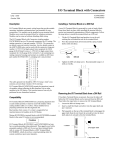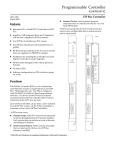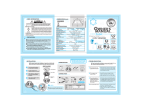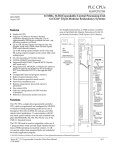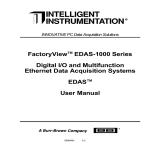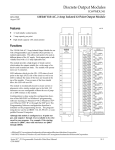Download The FIP Bus
Transcript
1 Bus Expansion Modules IC697BEM742, IC697BEM744 62 FIP Bus Controller GFK-1002E January 1998 Bus Expansion Modules a45466 Features H Interfaces FIP or World FIP I/O serial bus to IC697 PLC H Two versions available for standard IC697 racks: IC697BEM742 and IC697BEM744 - both have 2M of RAM and 2M of Flash memory H Data rate for IC697BEM742 is 1 Mbit/second, IC697BEM744 is 2.5 Mbits/second H H Four FIP Bus Controllers per PLC system H RS-485 serial port attaches to PC for easy in-system firmware upgrade (no PROMS to change) H Pushbutton for resetting Bus Controller and enabling Bus Controller to accept upgrades H FIP bus faults managed by PLC Alarm processor Function H H Six status LEDs OK RUN CD 1 TEN 1 CD 2 TEN 2 BEM 742 FIP FIELDBUS CONTROLLER FIP FIELDBUS DUAL CHANNEL CONTROLLER FIP CH S2 1 MHZ PUSH TO RESET MODULE Two FIP bus channels provide redundant bus capability CHANNEL 1 6 D+ 7 D– CHANNEL 2 6 D+ 7 D– MODULE IC697BEM742 LABEL 44A735979–003R01 Software configuration (no DIP switches or jumpers to set) using Windowsr programming software configuration function running on Windowsr 95 or Windows NTr Functions A FIP Bus Controller (FBC) is a two channel bus controller that occupies a single slot in an IC697 PLC standard or VME Integrator rack. I/O devices on the FIP bus are scanned asynchronously by the bus controller and I/O data is transferred to the CPU once per scan. Up to 31 Bus Controllers, of any kind, can be included in an IC697 PLC system. Of the 31 Bus Controllers, a maximum of four can be FIP Bus Controllers. A FIP bus may serve: H H H IC697 and IC693 PLCs interfaced to the bus by FIP Bus Controllers. Remote Drops, IC693 I/O racks that are interfaced to the bus through Remote I/O Scanner Modules. Each remote drop can include any mix of discrete and analog I/O modules. Field Control Stations, Field Control I/O modules that are interfaced to the bus via a FIP Bus Interface Unit (BIU). * BEM742 shown; BEM744 looks the same except for door label H Generic Devices, such as general-purpose computers that are interfaced to the bus via a 3rd Party FIP Module. A FIP bus is used primarily for I/O control. It is also used to store configuration data to remote devices and to report faults. r MS-DOS, Windows, Windows 95, and Windows NT are registered trademarks of Microsoft Corporation. t Series 90 -70 Programmable Controller Data Sheet Manual GFK-0600F 62-1 Bus Expansion Modules 2 GFK-1002E January 1998 FIP Bus Controller which allows IC693 I/O modules to be on the FIP Bus. The IC693 Remote I/O Scanner and the modules it serves are referred to as a FIP I/O Nest. For detailed information on the IC693 Remote I/O Scanner, refer to the Remote I/O Scanner User’s Manual. Location in a System A FIP Bus Controller module can be installed in any I/O slot in the CPU rack of an IC697 PLC system. The following figure shows a typical installation with a FIP Bus Controller connected to an IC693 Remote I/O Scanner IC697 PLC IC697 PLC a46559 FBC CPU PS FBC CPU PS Optional Redundant FIP I/O Bus FIP I/O Bus Remote I/O Rack Remote I/O Nest Î Î ÎÎÎÎ Î FBC Generic Device Î Î Î CPU FIP Interface Module PS Î Î ÎÎÎÎ ÎÎÎÎÎ Î Î Î ÎÎÎÎÎ ÎÎÎÎÎ Scanner Up to 8 Field Control modules (4 shown). Î Î Î PS Field Control I/O Station FIP Bus Interface Unit IC693 PLC Optional Expansion Rack Figure 1. Example of FIP Bus Controller In a System Installing a FIP Bus Controller H H H Installation should not be attempted without referring to the applicable Programmable Controller Installation Manual and the FIP Bus Controller User’s Manual. H Push the FIP Bus Controller into the card guide until it is aligned with the connector on the rack backplane. H While pressing the upper and lower flanges on the left of the module, push it into the connector until it clicks onto the rack rails. Be sure that the board has seated properly in the connector. H Bus connections to the connectors on the front of the module can now be made. Be sure that rack is powered down. Position the FIP Bus Controller at its intended slot location in the rack. 62-2 t Series 90 -70 Programmable Controller Data Sheet Manual GFK-0600F Bus Expansion Modules 3 GFK-1002E January 1998 FIP Bus Controller a45465 Status LEDs The six LEDs located on the front of the FIP Bus Controller display module status and communications activity. MODULE OK LED RUN LED CARRIER DETECT CH 1 LED TRANSMIT ENABLE CH 1 LED CARRIER DETECT CH 2 LED TRANSMIT ENABLE CH 2 LED BEM 742 The top two LEDs indicate module health. The bottom four LEDs indicate communications activity on the FIP bus. Two LEDs are dedicated to each of the two FIP channels. FIP RESTART PUSHBUTTON FIELDBUS DUAL CHANNEL CONTROLLER FIP CH S2 1 MHZ PUSH TO RESET MODULE SERIAL PORT RS–485 COMPATIBLE CHANNEL 1 6 D+ 7 D– CHANNEL 2 6 D+ 7 D– MODULE IC697BEM742 LABEL 44A735979–003R01 FIP BUS CHANNEL 1 CONNECTOR MODULE OK Shows the status of the FIP Bus Controller. This LED blinks during power-up diagnostics and should remain on as long as power is applied to the Bus Controller. RUN Shows the operational status of the FIP Bus Controller. This LED turns ON when the module is acting as the Bus Arbiter for the FIP network. CARRIER DETECT CH 1 This LED is ON when detecting a carrier signal on the FIP bus attached to channel 1. TRANSMIT ENABLE CH 1 FIP BUS CHANNEL 2 CONNECTOR This red LED is ON when the FIP Bus Controller transmits data on the FIP bus attached to channel 1. CARRIER DETECT CH 2 This LED is ON when detecting a carrier signal on the FIP bus attached to channel 2. BEM 742 TRANSMIT ENABLE CH 2 * BEM742 is shown; BEM744 looks the same except for door label Figure 2. FIP Bus Controller Module - User Features FIP Bus Controller Description Following is a basic description of the module features (refer to Figure 2 for location of hardware features). t Series 90 -70 Programmable Controller Data Sheet Manual GFK-0600F This red LED is ON when the FIP Bus Controller transmits data on the FIP bus attached to channel 2. Pushbutton A pushbutton located directly below the LEDs is provided as a means to enable the Bus Controller to accept an upgrade of its operating firmware. It is also used to locally reset the Bus Controller in the event of a watchdog timeout. 62-3 Bus Expansion Modules 4 GFK-1002E January 1998 FIP Bus Controller Serial Connector The FIP Bus The 15-pin Serial Connector on the FIP Bus Controller provides for attachment of a PC computer to perform an upgrade of the operating firmware of the Bus Controller. The port supports the RS-485 electrical standard. The FIP bus is a shielded twisted-pair wire. Proper cable selection is critical to successful operation of the system. Suitable cable types are listed in the FIP Bus Controller User’s Manual. Table 1. RS-485 Serial Port Pin Assignments Pin Number 1 Signal Name Pin Number Shield Ground 9 Signal Name Termination Resistor* 2 no connection 10 RXD– 3 no connection 11 RXD+ 4 ATTACH 12 TD– 5 +5V (5 Volts DC) 13 TD+ 6 RTS– 14 RTS+ 7 0V (DC Ground) 15 CTS+ 8 CTS+ Shell Conservative wiring practices, as well as national and local codes, require physical separation between control circuits and power distribution or motor power. Refer to sections 430 and 725 of the National Electric Code. Table 3. FIP Bus Characteristics Bus Type Single twisted pair plus shield. Fiber optics cable and modems can also be used. Baud Rate BEM742: 1.0 Mbaud BEM744: 2.5 Mbaud Maximum Bus Length 1000 meters per section (for 1.0 Mbaud,); 500 meters per section for 2.5 Mbaud Board Frame Ground 4000 meters per network for 1.0 Mbaud; 2000 meters per network for 2.5 Mbaud. 3 repeaters per network. * A 120 ohm resistor is capacitively coupled to the board frame ground. FIP Bus Connectors (Channel 1 and 2) Two 9-pin connectors on the FIP Bus Controller provide for attachment of one or two FIP busses. The top 9-pin connector is for FIP bus Channel 1 and the bottom 9-pin connector is for FIP bus Channel 2. Since signals on both busses are identical, the two busses provide a redundant bus capability. Table 2. FIP Bus Connector Pin Assignments Pin Number Signal Name Pin Number Signal name 1 no connection 6 D+ 2 no connection 7 D– 3 no connection 8 no connection 4 no connection 9 no connection 5 no connection Shell Maximum Number of Devices 32 devices per section DataEncoding Manchester II Encoding Connecting the Serial Bus For information about bus selection and installation, please refer to the FIP Bus Controller User’s Manual. Connect the bus cable to the connector(s) on the front of the Bus Controller. When installed in a single media or simplex configuration, either connector can be used. When installed in a dual media or redundant configuration, both the Channel 1 and 2 connectors must be used. Both connectors accept a standard 9-pin D-type male connector. D+ D– Signal Ground* Channel 1 * The connector shell is capacitively coupled to the board frame ground. Note that if cables with plastic shell connectors are not connected to both ports, the provided plastic connector cover and nylon screws should be used to cover the exposed metal connector of the FIP communication port not used. 62-4 D+ D– t Channel 2 Series 90 -70 Programmable Controller Data Sheet Manual GFK-0600F Bus Expansion Modules 5 GFK-1002E January 1998 FIP Bus Controller Bus Controller Operation H The Bus Controller handles all data transfer between the PLC and the devices on its bus. In order to do this, the Bus Controller must interface two completely separate and asynchronous activities: Allows the broadcast of any aperiodic I/O data by any 3rd Party device but only for the maximum time configured (optional) H Allows the transmission of any messages by any device but only for the maximum time configured (optional) H Receives a diagnostic message from each IC6** device A. The FIP bus scan, a cycle of communications between the devices on a bus (including the Bus Controller itself). B. The CPU sweep, the cycle of actions that includes communications between the CPU and the Bus Controller. The Bus Controller manages data transfer between the bus and the CPU by maintaining two separate on-board RAM memories. One interfaces with the bus and the other interfaces with the CPU. The Bus Controller automatically transfers data between these two memories, making data available to the bus or to the CPU when it is needed. The FIP Bus Scan A FIP bus scan (also referred to as a macro-cycle) consists of a fixed set of operations that are repeated as long as the RUN LED of the FIP Bus Controller is ON. The length of the macro-cycle, once configured never varies. Therefore, the bus scan is fixed. Diagnostics FIP devices on the bus will automatically report faults, alarms and certain other predefined conditions to the PLC. The Bus Controller stores any diagnostic messages it receives. They are read automatically by the IC697 CPU. Faults can then be displayed in the fault table using the Windows programming software and cleared from the programmer. Detailed information on faults on the FIP bus can be found in Chapter 5 of the FIP Bus Controller User’s Manual. In addition to the built-in diagnostics capabilities of FIP devices, the Windows programming software application program can make use of additional diagnostics mechanisms provided by the IC697 PLC. H System Status References that have been defined for FIP use. H Fault and No Fault contacts that can be used to detect fault and lack of fault conditions. H Alarm contacts that can be used to indicate when an analog value has reached an assigned alarm limit. During the bus scan, the FIP Bus Controller: H Requests all produced data from all devices to be broadcast on the FIP network, at the predefined period H Independently tests the presence of any remote devices (optional) Table 4. Applicable Manuals Reference t Title 1 IC697 FIP Bus Controller User’s Manual 2 IC693 FIP Remote I/O Scanner User’s Manual 3 IC670 FIP Bus Interface Unit User’s Manual 4 Programmable Controller Installation Manual 5 Programming Software User’s Manual 6 Programmable Controller Reference Manual Series 90 -70 Programmable Controller Data Sheet Manual GFK-0600F 62-5 Bus Expansion Modules 6 GFK-1002E January 1998 FIP Bus Controller Table 5. Specifications for IC697BEM742/BEM744 [ OperatingConditions: Atmospheric Pressure 80 kPa to 108 kPa Storage and TransportCharacteristics Atmospheric Pressure 66 kPa to 108 kPa Free Fall 250mm (9.84 inches) GeneralSpecifications Module Operating Voltage 5 VDC (from backplane) ModuleCurrent Drain 1.4 Amps, typical Memory for IC697BEM742 2 Megabytes of RAM, 2 Megabytes of Flash Memory for IC697BEM744 2 Megabytes of RAM, 2 Megabytes of Flash LEDs OK RUN CD 1 TEN 1 CD 2 TEN 2 Data Rate for IC697BEM742 Data Rate for IC697BEM744 Protocol VME 1Mbit/second 2.5Mbits/second FIP/W orld FIP System designed to support the VME standard C.1 Module OK Bus Arbiter Status Carrier Detect Channel 1 Transmit Enable Channel 1, Carrier Detect Channel 2 Transmit Enable Channel 2 [ Refer to GFK-0867B, or later for product standards and general specifications. For installations requiring compliance to more stringent requirements (for example, FCC or European Union Directives), refer to InstallationRequirements for Conformance to Standards. Table 6. Ordering Information Description Catalog Number FIP Bus Controller Module, 2 Mbytes of RAM and 2 Mbytes of Flash memory (Data Rate: 1 Mbit/second) IC697BEM742 FIP Bus Controller Module, 2 Mbytes of RAM and 2 Mbytes of Flash memory (DataRate:2.5Mbit/second) IC697BEM744 Note: For Conformal Coat option, or Low Temperature Testing option please consult the factory for price andavailability. 62-6 t Series 90 -70 Programmable Controller Data Sheet Manual GFK-0600F






